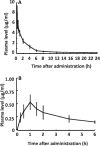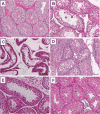Adjudin targeting rabbit germ cell adhesion as a male contraceptive: a pharmacokinetics study
- PMID: 18802200
- PMCID: PMC4381873
- DOI: 10.2164/jandrol.108.004994
Adjudin targeting rabbit germ cell adhesion as a male contraceptive: a pharmacokinetics study
Abstract
Adjudin (1-(2,4-dichlorobenzyl)-1H-indazole-3-carbohydrazide; formerly called AF-2364) has been shown to inhibit spermatogenesis by disrupting anchoring junctions at the Sertoligerm cell interface. This, in turn, leads to germ cell loss from the seminiferous epithelium, and transient infertility. Adjudin's efficacyin inhibiting spermatogenesis, the recovery of spermatogenesis after cessation of the drug, and side effects were examined in adult male Japanese rabbits. The pharmacokinetics profiles of adjudin in rabbits after oral administration and after intravenous injection were compared. Rabbits received 25 mg/kg adjudin once weekly for 4 consecutive weeks either by intravenous injection or by gavage. Vehicle-treated rabbits were used as controls. At 1, 2, 3, 4, and 8 weeks after treatment, testes were removed for microscopic examination to assess the status of spermatogenesis. Four weeks after intravenous cessation of adjudin, the recovery of spermatogenesis also was monitored. Blood was withdrawn after first administration to measure plasma concentrations of adjudin by high-performance liquid chromatography. Four weeks after intravenous treatment, examination of testis sections showed rapid exfoliation of elongated/elongating spermatids and the presence of large multinucleated cells; more than 95% of germ cells were absent from the seminiferous epithelium. Intravenous treatment showed a more severe disturbance of spermatogenesis compared with gavage treatment, which was correlated with bioavailability of the drug. The areas under the curve for intravenous injection and gavage were 20.11 +/- 1.90 and 2.23 +/- 0.45 mg x h x L(-1), respectively. These results illustrate the potential of adjudin as a male contraceptive, and the efficacy is associated with the bioavailability of the drug.
Figures





Similar articles
-
Adjudin, a potential male contraceptive, exerts its effects locally in the seminiferous epithelium of mammalian testes.Reproduction. 2011 May;141(5):571-80. doi: 10.1530/REP-10-0464. Epub 2011 Feb 9. Reproduction. 2011. PMID: 21307270 Free PMC article. Review.
-
A male contraceptive targeting germ cell adhesion.Nat Med. 2006 Nov;12(11):1323-8. doi: 10.1038/nm1420. Epub 2006 Oct 29. Nat Med. 2006. PMID: 17072312
-
The Sertoli-spermatid junctional complex adhesion strength is affected in vitro by adjudin.J Androl. 2006 Nov-Dec;27(6):790-4. doi: 10.2164/jandrol.106.000422. Epub 2006 Jun 28. J Androl. 2006. PMID: 16809272
-
AF-2364 [1-(2,4-dichlorobenzyl)-1H-indazole-3-carbohydrazide] is a potential male contraceptive: a review of recent data.Contraception. 2005 Oct;72(4):251-61. doi: 10.1016/j.contraception.2005.03.008. Contraception. 2005. PMID: 16181968 Review.
-
The Non-hormonal Male Contraceptive Adjudin Exerts its Effects via MAPs and Signaling Proteins mTORC1/rpS6 and FAK-Y407.Endocrinology. 2021 Jan 1;162(1):bqaa196. doi: 10.1210/endocr/bqaa196. Endocrinology. 2021. PMID: 33094326 Free PMC article.
Cited by
-
AF-2364 is a prospective spermicide candidate.Asian J Androl. 2010 May;12(3):322-35. doi: 10.1038/aja.2010.11. Epub 2010 Apr 26. Asian J Androl. 2010. PMID: 20418891 Free PMC article.
-
New frontiers in nonhormonal male contraception.Contraception. 2010 Nov;82(5):476-82. doi: 10.1016/j.contraception.2010.03.017. Epub 2010 May 6. Contraception. 2010. PMID: 20933122 Free PMC article. Review.
-
Adjudin, a potential male contraceptive, exerts its effects locally in the seminiferous epithelium of mammalian testes.Reproduction. 2011 May;141(5):571-80. doi: 10.1530/REP-10-0464. Epub 2011 Feb 9. Reproduction. 2011. PMID: 21307270 Free PMC article. Review.
-
Drug transporters, the blood-testis barrier, and spermatogenesis.J Endocrinol. 2011 Mar;208(3):207-23. doi: 10.1677/JOE-10-0363. Epub 2010 Dec 6. J Endocrinol. 2011. PMID: 21134990 Free PMC article. Review.
-
Interaction of oligomeric breast cancer resistant protein (BCRP) with adjudin: a male contraceptive with anti-cancer activity.Curr Mol Pharmacol. 2014;7(2):147-53. doi: 10.2174/1874467208666150126154049. Curr Mol Pharmacol. 2014. PMID: 25620224 Free PMC article. Review.
References
-
- Altman DG, Machin D, Bryant TN, Gardner MJ. Statistics with confidence. 2. London: BMB Books; 2000. Confidence interval analysis [software included with book purchase]
-
- Chen YM, Lee NP, Mruk DD, Lee WM, Cheng CY. Fer kinase/FerT and adherens junction dynamics in the testis: an in vitro and in vivo study. Biol Reprod. 2003;69:656–672. - PubMed
-
- Cheng CY, Mruk D, Silvestrini B, Bonanomi M, Wong CH, Siu MK, Lee NP, Lui WY, Mo MY. AF-2364 [1-(2,4-dichlorobenzyl)-1H-indazole-3-carbohydrazide] is a potential male contraceptive: a review of recent data. Contraception. 2005;72:251–261. - PubMed
-
- Cheng CY, Silvestrini B, Grima J, Mo MY, Zhu LJ, Johansson E, Saso L, Leone MG, Palmery M, Mruk D. Two new male contraceptives exert their effects by depleting germ cells prematurely from the testis. Biol Reprod. 2001;65:449–461. - PubMed
-
- Lee NP, Cheng CY. Protein kinases and adherens junction dynamics in the seminiferous epithelium of the rat testis. J Cell Physiol. 2005;202:344–360. - PubMed
Publication types
MeSH terms
Substances
Grants and funding
LinkOut - more resources
Full Text Sources
Other Literature Sources

